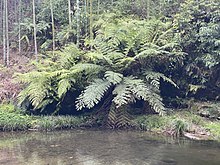Cyatheaceae
| Cyatheaceae Temporal range:
| |
|---|---|

| |
Cyathea glauca
| |
| Scientific classification | |
| Kingdom: | Plantae |
| Clade: | Tracheophytes |
| Division: | Polypodiophyta |
| Class: | Polypodiopsida |
| Order: | Cyatheales |
| Family: | Cyatheaceae Kaulf. |
| Genera | |
| Synonyms | |
| |
The Cyatheaceae are a
The family includes the world's tallest tree ferns, which reach heights up to 20 m. They are also very ancient plants, appearing in the
The Cyatheaceae usually have a single, erect or creeping

Cyatheaceae can be distinguished from arborescent
Taxonomy
As of 2019[update], two different circumscriptions of the family Cyatheaceae are used, as summarized in the table below. In the Pteridophyte Phylogeny Group classification of 2016 (PPG I), the family is one of eight in the order Cyatheales, and has three genera.[1] In the classification of Christenhusz & Chase (2014), the family is the only one in the order Cytheales, the families of PPG I being reduced to subfamilies. It then has 13–14 genera.[2] The sensu stricto circumscription of PPG I is used here.
| PPG I (2016) | Christenhusz & Chase (2014) |
|---|---|
| Order Cyatheales A.B.Frank | Order Cyatheales A.B.Frank |
| Family Cyatheaceae Kaulf. | |
| Family Thyrsopteridaceae C.Presl |
Subfamily Thyrsopteridoideae B.K.Nayar |
| Family Loxsomataceae C.Presl | Subfamily Loxsomatoideae Christenh. |
| Family Culcitaceae Pic.Serm |
Subfamily Culcitoideae Christenh. |
| Family Plagiogyriaceae Bowe |
Subfamily Plagiogyrioideae Christenh. |
| Family Cibotiaceae Korall |
Subfamily Cibotioideae Nayer |
| Family Metaxyaceae Pic.Serm. |
Subfamily Metaxyoideae B.K.Nayar |
| Family Dicksoniaceae M.R.Schomb. | Subfamily Dicksonioideae Link |
| Family Cyatheaceae Kaulf. | Subfamily Cyatheoideae Endl. |
Genera
Since the exact number of species is not known, classification of the Cyatheaceae s.s. has had a long and controversial history, and is still undergoing revision. Three tentative clades have been developed: Alsophila, Cyathea, and Sphaeropteris. These are frequently used as genus names. Cnemidaria, Trichopteris (or Trichipteris), and Nephelea (or Nephelia) have also been suggested as genera. Initially, indusium and scale morphology were used to organize the Cyatheaceae into taxonomic ranks. Most recently, plastid DNA has been used, suggesting the Cyatheaceae should be split into four clades: Sphaeropteris, Cyathea, Alsophila, and Gymnosphaera + A. capensis. As of 2007[update], it remained unclear which of these groups should be considered genera and which subgenera.[3]
The Pteridophyte Phylogeny Group classification of 2016 (PPG I) accepts three genera, placing the Gymnosphaera clade within Alsophila:[1]
- Alsophila R.Br., about 275 species
- Cyathea Sm., about 265 species
- Sphaeropteris Bernh., about 103 species
| Dong and Zuo 2018[6] | Nitta et al. 2022[7] and Fern Tree of life[8] |
|---|---|
References
- ^ S2CID 39980610.
- ^ PMID 24532607.
- ^ PMID 21636456. Retrieved 2019-08-22.
- ^ Judd, W.S., C.S. Campbell, E.A. Kellogg, P.F. Stevens, and M.J. Donoghue (Eds.) 2008. Plant Systematics: A Phylogenetic Approach, Third Edition. Sinauer Associates, Sunderland, Massachusetts, USA.
- ^ Holttum, R.E. and P.J. Edwards. 1983. The tree-ferns of Mount Roraima and neighbouring areas of the Guayana highlands with comments on the family Cyatheaceae. Kew Bulletin 38(2): 155-188.
- S2CID 90852235.
- PMID 36092417.
- ^ "Tree viewer: interactive visualization of FTOL". FTOL v1.3.0. 2022. Retrieved 12 December 2022.
- Large, M.F. and J.E. Braggins Tree Ferns. Timber Press (2004). ISBN 0-88192-630-2
